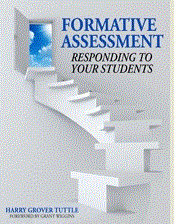I teach a freshmen college English course. I’ve been using formative assessment throughout the course. We do at least five very structured formative assessment peer reviews before we even write a draft (Successful Student Writing Through Formative Assessment). During today’s class, we peer reviewed a draft of their contrast essay. I asked the class to vote whether they wanted 1) to hand in their essays the next class which was just before the vacation or 2) to do another peer review and have the essays due after Spring Break. I told them I would do whichever they wanted. 90% voted to have their essays peer-reviewed again. They wanted more formative feedback so that their writing could improve! One student even boasted as he showed me his peer-reviewed draft, “Look at all the ways I can do better!”
How do you use formative assessment to constantly assess students and to “instantly” help them to improve?
My book, Formative Assessment: Responding to Your Students, is available through Eye on Education.
Also, my book, Successful Student Writing Through Formative Assessment, is available through Eye on Education.














 Formative Assessment and Successful Student Writing Through Formative Assessment by Harry Grover Tuttle
Formative Assessment and Successful Student Writing Through Formative Assessment by Harry Grover Tuttle


How valuable is Peer Review?
Published December 15, 2008 Change , Comment , Composition , Edublogger , Education , ELA , English , Feedback , peer , Peer Review , Review , Revision , write , Writing Leave a CommentTags: Change, Comments, Composition, edublooger, Education, English, Essay, Feedback, Improve, peer, Peer Review, Revision, write, Writing
When my students hand in their final English essay, they also hand in their peer reviewed draft. I’ve noticed that usually they do not incorporate the changes that peers suggest.
I gave them a survey on peer review to help me better understand their use of peer’s comments. They admitted that they use very little of peer review.
Some of their reasons:
The reviewer isn’t as smart as I am.
I don’t care what they “feel” about my paper. What is good/bad according to the rubric?
They don’t understand the rubric.
It does not help me when a reviewer finds a mistake if he cannot tell me how to fix it.
They don’t understand my thinking/how I wrote the paper.
The reviewer found some spelling mistakes but missed the big things like my first body paragraph having two topics.
They don’t try/ they do not take it seriously.
How well do your students peer review each other? How valuable is the peer review to the author?
For any one who is interested in implementing formative assessment in the classroom, my book,
Formative Assessment: Responding to Students is available through Eye-on-Education.